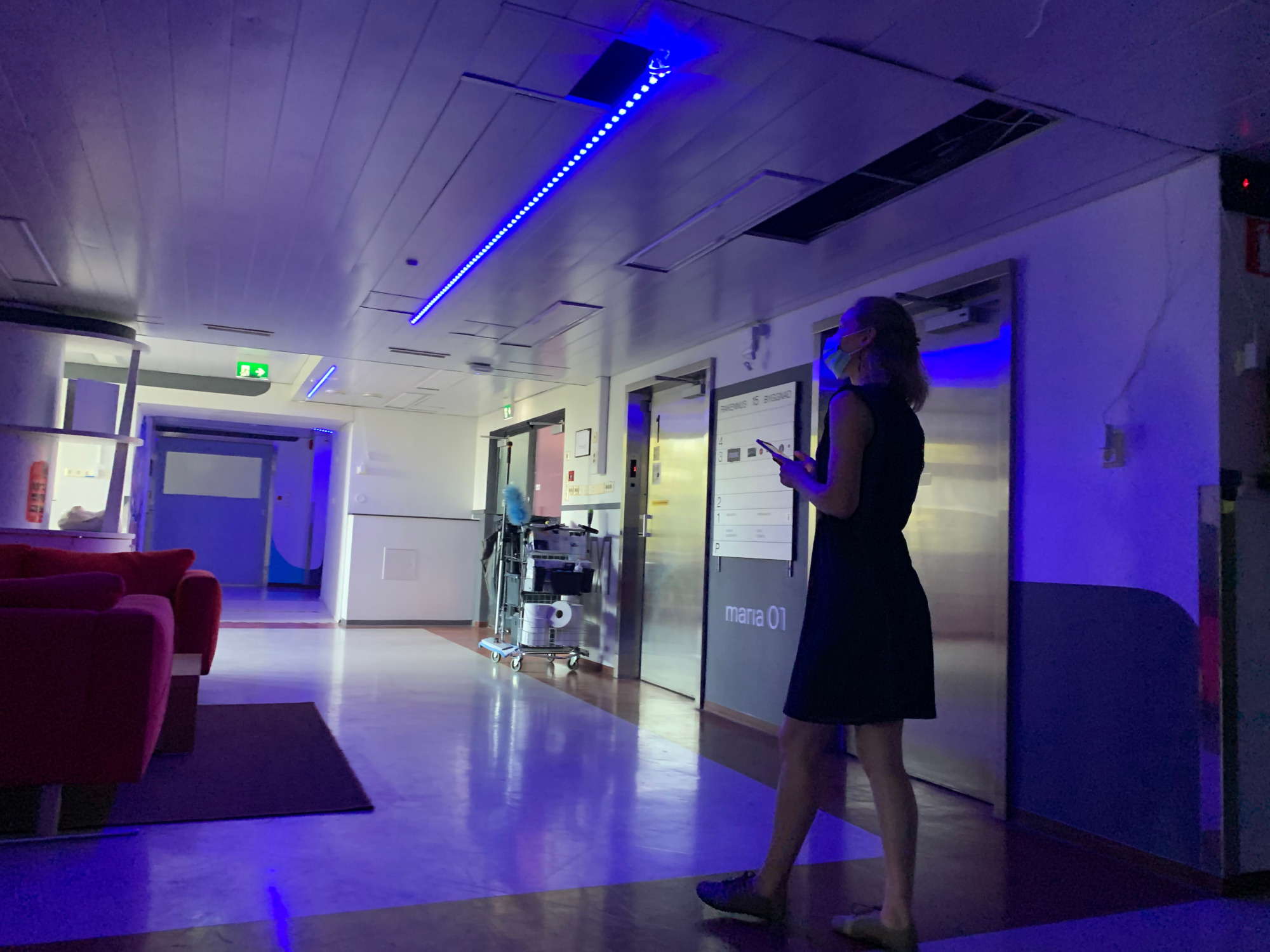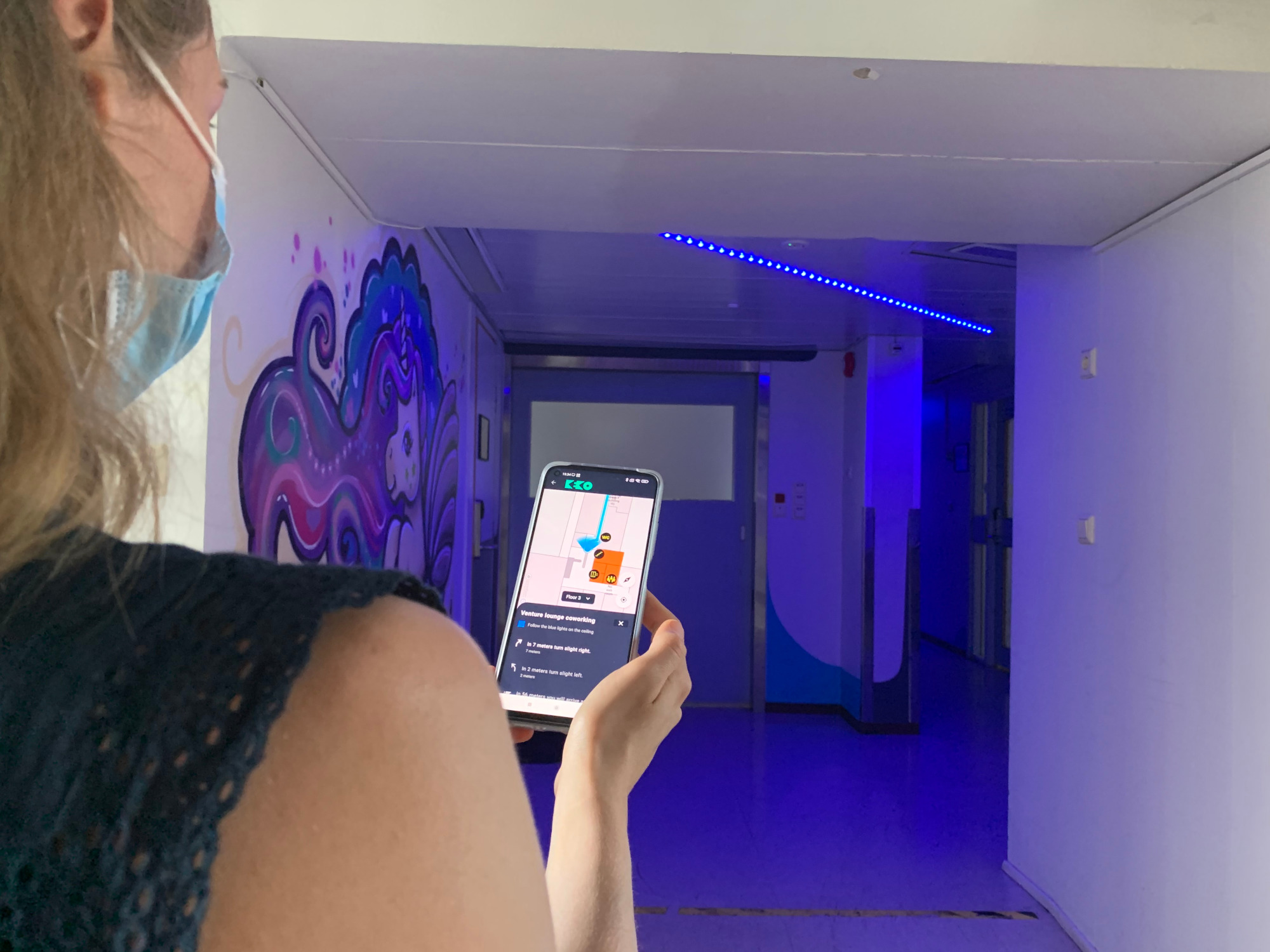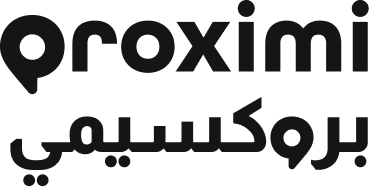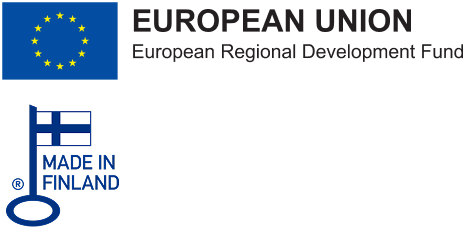Mobile wayfinding is a concept that is becoming a part of our everyday life. But imagine taking that one step further. Just pick a destination in your phone app, and the building will lead you the way. This futuristic vision was turned into reality on Europe’s leading start-up campus Maria01 where Proximi.io showcased an unprecedented solution to control smart lights as part of mobile real-time indoor navigation. Users simply activate navigation mode on the app, and coloured LED smart lights around them will start leading the way. The logic also keeps constantly track of the movement of the user, adjusting the route accordingly and turning off the lights behind them. The smart light wayfinding solution was implemented as part of the KEKO Wayfinder project conducted in close cooperation with leading players of the industry, like KONE, Nokia, UnSeen Technologies and Emblica.
Why use smart lights as navigation-aid?
Spatial lighting plays an important role in wayfinding. Lighting serves as an intuitive cue for orientation and following the direction of the light is practically second nature for humans. This fact is widely acknowledged and made use of in design, urban planning, engineering, and architecture. Connecting our mobile wayfinding solution to smart lights in the building benefits users in many ways. Relying less on active phone usage, navigating along real-time updated light routes is more accessible, effortless, timesaving and experience-rich the navigating user. The results from end user tests conducted by KONE are pointing in the same direction: users feel very drawn to the lighting-based navigation solution and experienced our hands-free navigation as effortless and convenient.

 Navigation made easy and accessible by Proximi.io. Pick a destination on your mobile wayfinding app and smart lights will light up to lead you the way
Navigation made easy and accessible by Proximi.io. Pick a destination on your mobile wayfinding app and smart lights will light up to lead you the way
KEKO mobile wayfinding app in a nutshell
The KEKO Wayfinder project brought together experts from leading companies in smart building industry like KONE, Nokia, UnSeen Technologies, Emblica and other companies involved in the KEKO Ecosystem. During the pilot the team put into practice novel ways for users to interact with a smart building through their mobile devices. As a result, a versatile mobile app for visitors and members of Maria01 was produced. The mobile solution combined Proximi.io’s smart light -driven navigation and our state-of-the-art mobile wayfinding SDK, UnSeen’s network of sensors measuring CO2, noise levels and occupancy of spaces with space booking features from Maria’s own Officernd. Additionally, the noise level information was turned into an AI-powered predictive model developed by Emblica, which helps users find spaces which are typically calm. All these components came together from the Proximi.io API, Maria’s Officernd and the KEKO API, forming a smooth, informative, and experience-rich application for the end user.
A 135-year-old campus becomes smart
The project was implemented on one of Europe’s largest start-up campuses, located in Helsinki, Finland. There could not have been a better place to deploy KEKO Wayfinder: The former hospital features 20 000 sqm of indoor area across a handful of buildings and counts more than 1300 members. The campus also has a notorious reputation to be tough to navigate with its over one hundred years old maze of corridors. But it’s never late to become smart, and that applies also to buildings past their 135th birthday. An extensive network of data-collecting sensors was installed into the meetings rooms, phone booths and co-working spaces of the campus. Also, as there were no smart lights present at Maria, Philips Hue Smart Lights were set up along the main navigation routes and connected to the internet with 4G WIFI routers.
One solution – many applications
The smart light guidance -based solution deployed at Maria01 contains a wide range of possibilities for future applications. The solution can be easily scaled according to different project types and requirements. Currently, the developed logic allows users to interact with smart lights for navigation around the building, but the functionality could be easily expanded to connect also with smart screens, elevators, or other elements in a smart building. Potentially, the solution could be implemented more statically into a web-based wayfinding solution, where for example the helpdesk or a smart screen could activate certain light routes for customers in need of guidance.
Meet our partners in the KEKO Wayfinder project
The Keko Ecosystem is consortium founded in 2020 by KONE, Nokia, YIT, Caverion, Halton, Netox and VTT with the main goal of creating the global standard in building data ecosystems. By integrating data of all technical systems in a built environment into a single platform, KEKO API, Keko aims to improve the comfort, productivity, and sustainability of buildings.
KONE is a global leader in the elevator and escalator industry. Kone’s mission is to improve the flow of urban life. In a Smart Building environment that means optimizing the user experience through the innovation of intelligent services.
Nokia offers a comprehensive portfolio of network equipment, software, services and licensing opportunities across the globe. In the KEKO project Nokia provides extensive analytics from the data collected in the pilot.
Emblica is a data science company that provides costumers with on data intensive applications, artificial intelligence and machine learning while combining a wide range of technologies.
UnSeen Technologies provides services covering end-to-end solutions including industrial design, hardware, software, wireless connectivity, NB-IoT and cloud services.
About us
Proximi.io technology can locate and guide people indoors and outdoors. Accordingly, the Proximity service provides indoor positioning, interactive maps, indoor navigation, and analytics.



